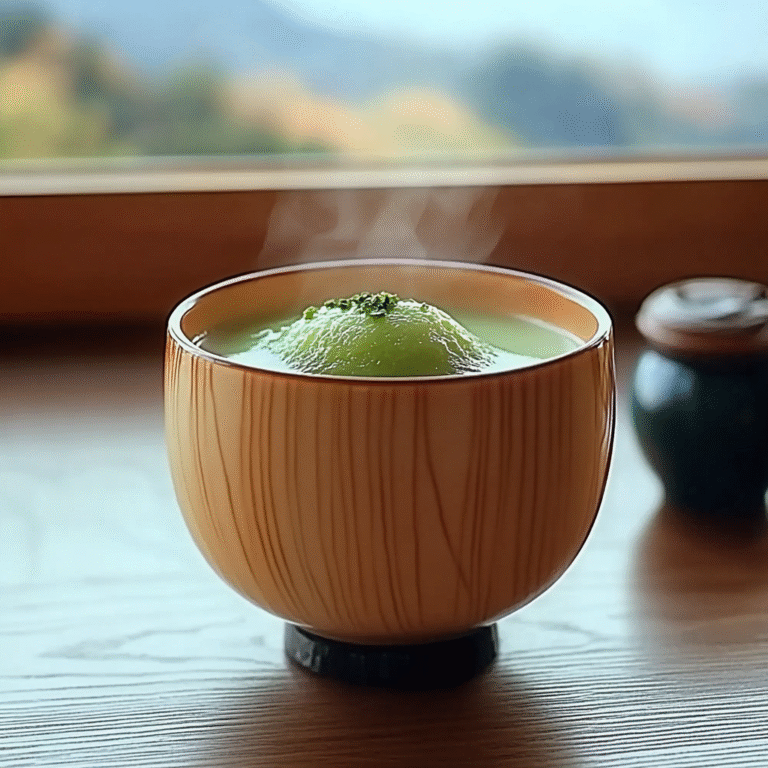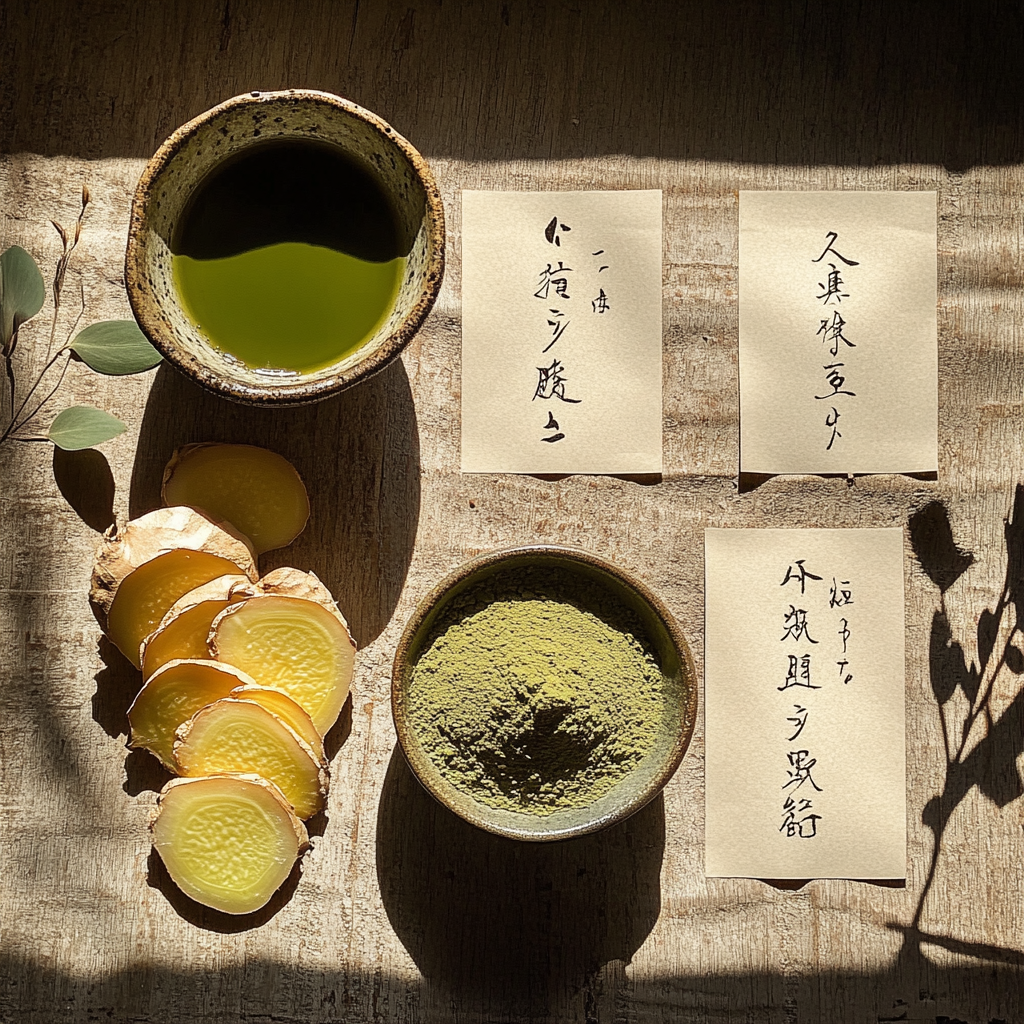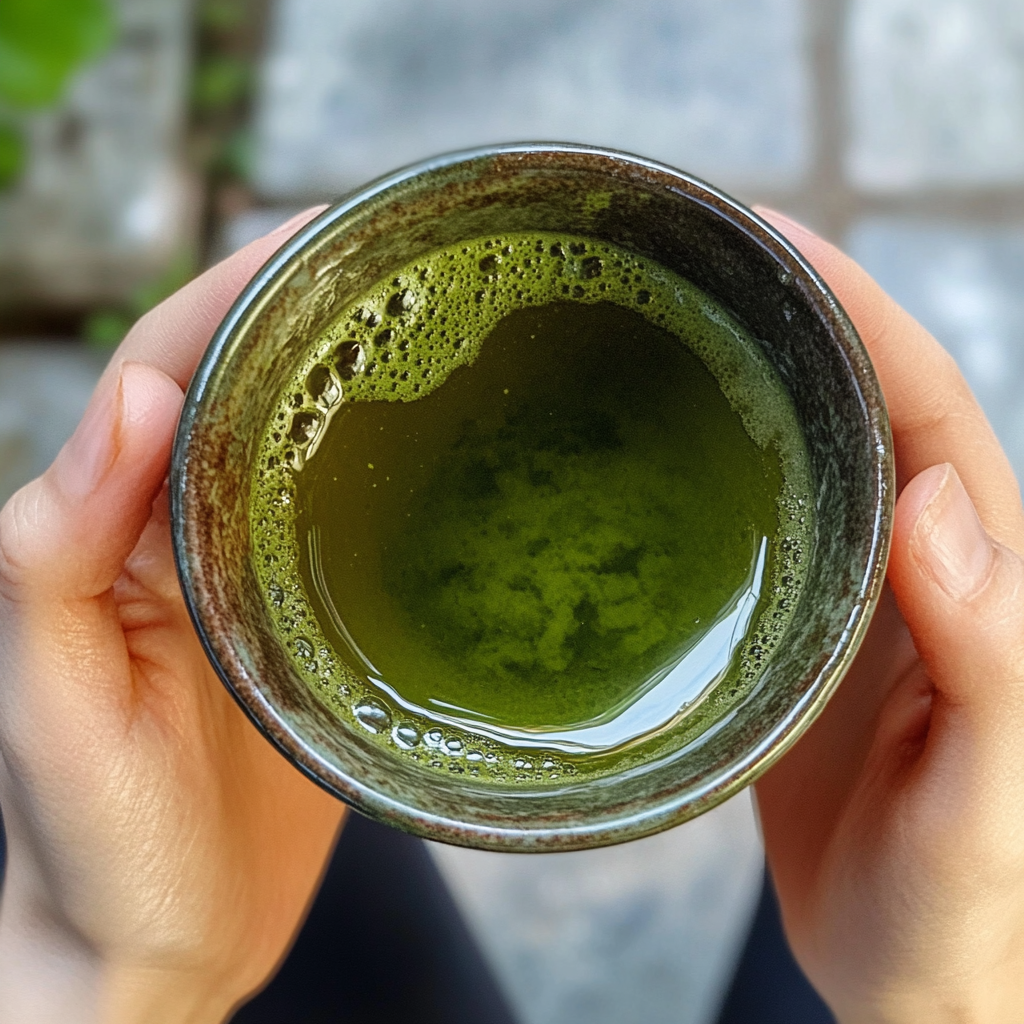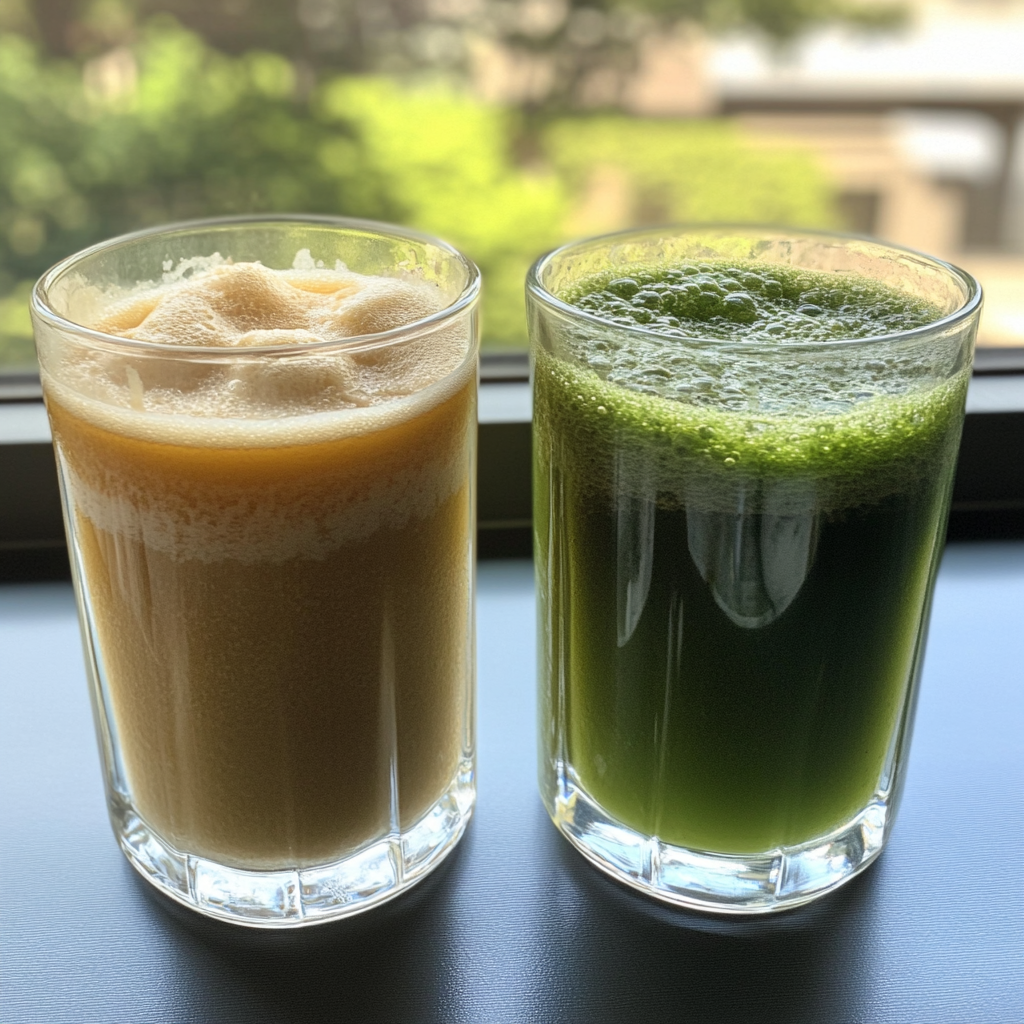Feeling bloated, sluggish, or just in need of a health reset? You’re not alone — studies show over 60% of adults seek natural detox solutions each year. That’s where the Japanese Mounjaro Recipe comes in.
This ancient-inspired drink blends matcha, kombu, ginger, and umeboshi (pickled plum) into a powerhouse elixir designed to detoxify, energize, and heal. I stumbled upon this gem while looking for holistic wellness remedies — and let me tell you, it changed my morning routine forever!
In this guide, I’ll walk you through the recipe, health benefits, ingredient breakdown, and how to make it your own. Whether you’re chasing energy, digestion support, or just a soothing ritual, this drink delivers. Let’s dive in!

Table of Contents
Table of contents
- What Is the Japanese Mounjaro Recipe? (Ancient Wellness Ritual Explained)
- Ingredients in the Japanese Mounjaro Recipe (And Why They Matter)
- How to Make the Japanese Mounjaro Recipe at Home (Step-by-Step Guide)
- Health Benefits of the Japanese Mounjaro Drink
- Japanese Mounjaro vs. Modern Detox Drinks
- Common Variations and Add-Ons to Customize Your Mounjaro Recipe
- Conclusion: Bring Japanese Wellness Into Your Daily Routine
- FAQs About Japanese Mounjaro Recipe :
What Is the Japanese Mounjaro Recipe? (Ancient Wellness Ritual Explained)
Okay, real talk — when I first heard about the Japanese Mounjaro recipe, I thought it had something to do with that diabetes medication. You too? Yeah, totally normal. But no, this has nothing to do with pharmaceuticals. What we’re talking about here is an ancient-inspired detox drink — rooted in traditional Japanese ingredients like kombu, umeboshi, and matcha — and it’s been quietly stealing the show in the wellness space.
Where This Drink Even Came From
I stumbled across the concept while deep-diving through a Japanese cooking blog during one of my “how do I fix my gut health” phases (please tell me I’m not alone). The blogger casually mentioned her grandmother making a morning tonic using kelp water and fermented plum. At first, I was like, Wait… seaweed in a drink? But curiosity won.
Turns out, this isn’t some trendy concoction made up on TikTok last week. It’s inspired by traditional Japanese tea rituals — the kind where preparation is meditative and every ingredient is intentional. Kombu (a dried seaweed loaded with minerals), umeboshi (a sour, fermented plum that’s like a digestive superfood), and matcha (yep, that frothy green tea we all love) come together to create a functional wellness drink.
This combo’s been used in various forms for centuries. Not under the name “Mounjaro,” of course — that’s something wellness bloggers cooked up to give it a modern twist.
Kombu, Umeboshi, and Matcha: The Holy Trio
Each ingredient brings something amazing to the table. Kombu gives your gut a mineral-rich broth and supports thyroid health thanks to its natural iodine. Umeboshi — whew — that stuff is intense, but it’s incredible for digestion. And then matcha? It gives you that smooth caffeine lift without the crash. Plus it’s packed with L-theanine, which helps with focus.
I remember the first time I made it, I totally overdid the umeboshi. I mashed two whole plums into my cup and couldn’t even finish it. That salty-sour punch? Yeah… stick to half a plum to start. Lesson learned.
From Hidden Gem to Health Blog Darling
Honestly, I thought I’d found some obscure ritual, but now I see it everywhere — Pinterest boards, YouTube shorts, even wellness influencers who swore off green drinks are talking about it. The name “Japanese Mounjaro recipe” caught on because it sounds kinda exotic and cool. But at its heart, it’s a natural detox drink that respects Japanese healing traditions.
If you’re into clean ingredients, slow living, and drinks that actually do something for your body, this might be your new go-to. Just don’t expect a sugar bomb or a bright pink smoothie. This is earthy, savory, and surprisingly comforting.
Print
Japanese Mounjaro Recipe for Weight Loss 2025
A natural Japanese detox drink made with matcha, kombu, ginger, and umeboshi — boosts digestion, supports energy, and promotes overall wellness.
- Total Time: 15 minutes
- Yield: 1 serving 1x
Ingredients
- 2–3 inch strip of dried kombu
- 1/2 tsp ceremonial grade matcha
- 1/2 umeboshi plum, pitted
- 1 thumbnail-sized piece of fresh ginger (grated)
- 1 cup warm water (not boiling)
- Optional: 1 tsp raw honey
- Optional: squeeze of fresh lemon or yuzu juice
- Optional: pinch of lemon zest
Instructions
- Place the kombu in a cup of warm (not boiling) water and let it steep for 10–15 minutes.
- In a separate bowl, whisk 1/2 tsp matcha with hot water (approx. 175°F) until frothy.
- In a mug, mash 1/2 umeboshi plum with grated ginger into a pulp.
- Strain out the kombu and pour the infused water into the mug.
- Add the whisked matcha to the mug and stir gently to combine.
- Optional: Add raw honey, lemon/yuzu juice, or lemon zest to customize the flavor.
- Sip warm and enjoy slowly as a wellness ritual.
Notes
Do not boil the kombu; soaking in warm water preserves its flavor and nutrients. Adjust umeboshi quantity based on taste preference — start with half a plum to avoid overpowering sourness.
- Prep Time: 5 minutes
- Cook Time: 10 minutes
- Category: Detox Drink
- Method: No Cook
- Cuisine: Japanese
- Diet: Vegan
Nutrition
- Serving Size: 1 cup
- Calories: 25
- Sugar: 1g
- Sodium: 200mg
- Fat: 0g
- Saturated Fat: 0g
- Unsaturated Fat: 0g
- Trans Fat: 0g
- Carbohydrates: 5g
- Fiber: 1g
- Protein: 1g
- Cholesterol: 0mg
Ingredients in the Japanese Mounjaro Recipe (And Why They Matter)
When I first tried making the Japanese Mounjaro recipe, I had no clue what half of the ingredients were. Kombu? Umeboshi?? I legit thought I needed to take a field trip to Japan to even start. But after some digging (and a few clumsy first tries), I figured it out — and honestly, once you know what each ingredient does, it makes the whole ritual feel that much more powerful.
Let’s break down the good stuff.
Matcha: Green Gold in a Bowl
Okay, matcha I did know. I mean, who hasn’t had a matcha latte by now, right? But I didn’t realize how different ceremonial grade matcha is from the sugary coffee shop versions. Real matcha is loaded with antioxidants — like, we’re talking more than blueberries — and it gives you this clean, focused energy from the natural L-theanine.
No jitters. No crash. Just this subtle alertness that honestly makes you feel like you’re operating on a higher frequency. I started swapping my second cup of coffee for matcha, and wow — total game-changer.
Kombu: The Seaweed That Changed My Gut
Now kombu scared me at first. I mean, it’s dried seaweed. But once I learned to soak it in warm water to create a kind of mineral broth, I was hooked. Kombu is rich in iodine, which your thyroid loves, and full of trace minerals that help your gut bacteria thrive.
Pro tip? Don’t boil it. That makes it slimy and funky. Just let it steep like a tea bag for 10-15 minutes. It gives the drink this earthy, almost umami depth.
Umeboshi: Small But Mighty Plum Power
Umeboshi is where things get… intense. It’s this pickled plum that’s wildly tangy, salty, and fermented — like a punch in the mouth, in the best way. Traditionally used for digestion and detox, it really wakes up your taste buds. I use about half a plum per cup and mash it gently so it dissolves.
First time I tried it, I used a whole one and practically puckered myself into next week. Start small!
Ginger: The Soothing Spice
Ginger’s a familiar friend. It brings warmth, fights inflammation, and calms the stomach. I usually grate a thumbnail-sized piece and steep it with the kombu. It adds just enough kick without overpowering the more subtle flavors.
Optional Add-ins: The Flavor Glow-Up
Now if you wanna get fancy (and I always do), try these:
- Lemon zest – adds brightness
- Raw honey – for a touch of sweetness and antimicrobial benefits
- Yuzu juice – for that uniquely Japanese citrus twist
Each of these gives the drink its own personality, so feel free to experiment. I rotate based on my mood or whatever’s in my fridge.

How to Make the Japanese Mounjaro Recipe at Home (Step-by-Step Guide)
I remember the first time I tried to make the Japanese Mounjaro recipe at home… it was a complete disaster. Boiling water went straight onto the kombu, the umeboshi didn’t get mashed properly, and—of course—I forgot the ginger. Yikes. The result tasted like salty ocean tea — not the healing elixir I was hoping for.
But hey, mistakes are how we learn, right?
After a few more tries (and way too much Googling), I finally nailed down a simple step-by-step method that keeps the flavors balanced and the benefits intact. Let me walk you through it so you don’t have to suffer the same seaweed-flavored disappointment I did.
1. Soak the Kombu (Don’t Boil It!)
Start with a small strip of dried kombu, about 2-3 inches long. Place it in a cup of warm water — not boiling — and let it steep for 10 to 15 minutes. This draws out the minerals and umami flavor without making it slimy.
Tip: You can prep this part the night before and leave it in the fridge if you’re not a morning person like me.
2. Whisk Your Matcha Like a Pro
In a separate bowl, scoop in about 1/2 teaspoon of ceremonial grade matcha. Add hot water (not boiling — around 175°F is perfect) and whisk briskly in a zig-zag motion until it turns frothy.
No bamboo whisk? No stress. A handheld milk frother or even a fork works in a pinch. It won’t be “ceremonial,” but hey — we’re not in a tea house.
3. Mash the Umeboshi and Ginger
In your serving mug, place half of a pitted umeboshi plum and about a thumbnail of fresh grated ginger. Mash it up using a spoon or muddler until you’ve got a juicy, pulpy paste at the bottom.
I tried skipping this once to save time — big mistake. You need that mash to distribute flavor and benefits properly.
4. Bring It All Together
Now strain out your kombu and pour the infused water into the mug with your plum and ginger paste. Add the whisked matcha next, and stir everything together gently. You want the flavors to meld, not go crazy.
5. Customize It (Optional but Fun)
Feeling fancy? Add:
- A squeeze of lemon or a splash of yuzu juice for brightness
- Raw honey for a little sweetness
- A pinch of lemon zest if you like a citrus aroma
Play around until it feels like your perfect morning tonic.
6. Sip Warm, Not Cold
This drink is meant to be sipped warm, almost like a meditation. It’s calming, earthy, a little salty, and oddly satisfying. I like to drink it slowly, especially on stressful days when I need a reset.
Once you get the hang of it, the whole thing takes less than 10 minutes to throw together. And trust me — it gets better every time you make it.

Health Benefits of the Japanese Mounjaro Drink
Let me tell you something honest — I didn’t start drinking the Japanese Mounjaro recipe because I was trying to “detox” or jump on some health bandwagon. I was just tired. Tired of the mid-afternoon slumps, the bloat after lunch, and that constant low-key brain fog. A friend swore by this odd little tonic she started making every morning, and even though I side-eyed the whole “fermented plum and seaweed” thing, I gave it a go.
Now it’s basically my secret weapon.
Here’s what I’ve noticed (and what science backs up too):
Gentle Detox That Doesn’t Feel Like a Cleanse
I used to roll my eyes at detox drinks. Most of them taste like cucumber sadness and leave you running to the bathroom. But this? This combo of ginger and umeboshi works with your body. Ginger gently stimulates your system, while umeboshi helps your liver do its job better — it’s been used in Japanese natural medicine for centuries as a way to help the body recover after stress, sickness, or even a little too much sushi.
Not gonna lie, the first week I drank it, I did notice… ahem, things moving. But in a good way.
Sustained Energy Without the Crash
Matcha is my MVP here. It has just enough natural caffeine to perk me up, but the real magic is the L-theanine — an amino acid that helps you stay calm and focused. It’s like turning your brain’s fog lights on without the buzz.
I’ve actually stopped drinking coffee after noon because this gives me a better energy lift without the post-latte crash or 3 PM anxiety spiral.
Gut Health = Mood Boost (No Joke)
Here’s the part I didn’t expect. Once I started drinking this consistently, I noticed less bloating and more regular digestion. That’s the kombu and umeboshi duo doing their thing. Kombu is full of prebiotics, and umeboshi is a fermented food — both are gold for your gut.
And guess what? A happy gut = a happier mood. There’s real science on that now, and I’ve felt it firsthand. I’m less cranky in the mornings, which my family definitely appreciates.
Anti-Inflammatory & Antioxidant Superpowers
Between the ginger, matcha, and fermented plum, this drink is stacked with antioxidants. That means it helps fight inflammation, protects your cells, and supports your immune system. I used to catch every cold that floated through the house — now? Not so much.
I even noticed my skin looking a bit clearer after a month or so. Could be coincidence, but I’m not complaining.
Natural but Potent — Without the Jitters
If you’re like me and sensitive to caffeine, this recipe is a lifesaver. You still get a little mental lift, but none of that heart-pounding nonsense that comes with energy drinks or strong coffee. It’s a calm, focused alertness — like your brain woke up without your body freaking out.
I wouldn’t say it’s a miracle drink — nothing is. But this has become one of those small, daily habits that makes a big difference over time. And it’s honestly kind of addicting once you start.

Japanese Mounjaro vs. Modern Detox Drinks
Alright, let’s have a real talk here — I’ve tried more “detox drinks” than I care to admit. I’ve bought the pricey green juices, downed the trendy charcoal lemonades, even gave one of those weird celery juice cleanses a go (yep… that was a regret). So when I first heard about the Japanese Mounjaro recipe, I wasn’t exactly optimistic. But dang, it turned out to be completely different — in the best way.
Let me break down how this traditional wellness tonic stacks up against most of the modern stuff lining health food shelves today.
Fewer Processed Ingredients (And You Can Pronounce Them All)
Most detox drinks you find in stores come with a mile-long ingredient list. Ever seen “monk fruit extract erythritol blend” on a label? Me too — no clue what that even means. The Japanese Mounjaro drink, though? It’s made with real food. Kombu. Umeboshi. Matcha. Ginger. Stuff you can literally hold in your hand and recognize from a farmers’ market.
There’s something so grounding about that simplicity. It feels like you’re fueling your body, not tricking it with lab-made “superfoods.”
A Gentle Caffeine Boost (Without Coffee Chaos)
Look, I love coffee… until it doesn’t love me back. Some modern detox drinks go either way too heavy on caffeine (looking at you, matcha lattes with espresso shots) or avoid it altogether, which leaves me feeling like I missed the energy part of the detox.
With Japanese Mounjaro, the matcha gives you just enough of a lift without frying your nervous system. I can sip it slowly in the morning and still feel focused by lunch — no crash, no jitters, just good vibes.
Mindfulness Is Baked Into the Ritual
One thing I really appreciate about this recipe? The act of making it feels almost meditative. Unlike grab-and-go detox powders, prepping the kombu, mashing the umeboshi, and whisking matcha into a frothy green swirl kind of forces you to slow down.
It’s like a mini ritual — and let’s be honest, we could all use a bit more mindfulness in our routines.
Minimalist, Sustainable Sourcing
This one’s underrated. Many store-bought detox drinks are packed in plastic bottles, flown across the world, and pumped with preservatives to stay “fresh.” Meanwhile, the Japanese Mounjaro drink is rooted in sustainability — dried kombu, fermented plums, powdered tea. All shelf-stable, naturally preserved, and incredibly low-waste.
Plus, everything can be bought in bulk with minimal packaging if you shop smart. Your body and the planet will thank you.
No Synthetic Sweeteners or Mystery Powders
Too many detox drinks sneak in sugar substitutes or powdered “proprietary blends.” Translation: stuff we don’t understand and probably don’t need. The Mounjaro drink? None of that. If you want sweetness, you add a dab of raw honey or a splash of yuzu — both natural, delicious, and easy to control.
And no chalky texture! Anyone who’s ever chugged a powdered cleanse drink knows what I mean.
In the end, the Japanese Mounjaro recipe isn’t trying to be flashy. It’s not neon-colored or bottled in frosted glass. But it’s real, it’s rooted in centuries of wellness wisdom, and it works quietly, gently, and effectively.
Honestly, once I made the switch, I didn’t look back.

Common Variations and Add-Ons to Customize Your Mounjaro Recipe
I’ll be honest — I don’t always make the Japanese Mounjaro recipe the same way twice. Some mornings I need something a little spicier, other days I want it more citrusy and refreshing. The beauty of this tonic is how easy it is to tweak while keeping its core benefits. Once you’ve got the base down, it’s like a wellness playground — you get to experiment and make it your own.
Here are some of my favorite customizations that I’ve tested (and sometimes failed at — more on that in a sec).
Brighten Things Up With Citrus
Citrus makes this drink sing. When I first added a bit of yuzu zest I had leftover from a recipe, I was hooked. It gave the Mounjaro tonic this fresh, floral brightness that cut through the kelp and plum beautifully.
Other great options:
- A squeeze of lemon juice for tartness and added vitamin C
- A thin slice of lime tossed into the cup — just don’t overdo it or it overpowers the matcha
One time I used bottled lemon juice… big mistake. Stick with fresh, trust me.
Spice It Up (Literally)
If you want to crank up the anti-inflammatory power, a pinch of turmeric and a dash of black pepper does wonders. The pepper actually helps your body absorb the turmeric better — neat little science fact I wish I’d known before adding turmeric alone and wondering why it wasn’t doing much.
For a warm twist, I’ve also tried cinnamon — especially in the colder months. It turns the Mounjaro into this cozy, hug-in-a-cup experience. Just don’t add too much or it’ll clash with the matcha.
Natural Sweeteners (In Moderation)
Some days I want a little sweetness, and a touch of raw honey hits the spot. It also soothes the throat and adds a lovely floral note. I’ve also experimented with:
- Monk fruit — no weird aftertaste, surprisingly pleasant
- Agave syrup — a good neutral option when you want something light
Pro tip: skip anything artificial. Tried stevia once… tasted like metal. Never again.
Summer-Ready: Cold Version
When it’s blazing hot out, I switch to an iced Mounjaro version. I make a kelp infusion, let it cool, then whisk chilled matcha and pour it all over ice with a citrus twist. Honestly, it’s like a Japanese spa in a glass — super refreshing and still gut-friendly.
Throw in a mint leaf or two and you’re basically winning summer.
Vegan and Fasting-Friendly Tweaks
The base recipe is naturally vegan and super clean. Just skip the honey and use maple syrup or monk fruit if you need a plant-based option.
If you’re doing intermittent fasting like I dabble with sometimes, just leave out any sweetener and sip it plain — the ingredients won’t break your fast, and you still get that energizing lift and digestive support.
Don’t Be Afraid to Experiment
In short? You can totally make this recipe work for your tastes and goals. It’s like a wellness formula you can remix, and honestly, playing around with the flavors is half the fun.
Next time you whip it up, try something new — and don’t be afraid to mess it up. Some of my favorite combos came from “happy accidents.”
Conclusion: Bring Japanese Wellness Into Your Daily Routine
The Japanese Mounjaro Recipe isn’t just a drink — it’s a ritual. With just a few simple ingredients, you’re treating your body to generations of traditional wisdom. Whether you’re detoxing after a holiday binge or just want a moment of calm, this recipe deserves a spot in your routine.
Try it, feel the difference, and don’t forget to pin it to your Pinterest board for easy access and to share the wellness magic with friends!

FAQs About Japanese Mounjaro Recipe:
The Japanese Mounjaro recipe is a traditional wellness drink inspired by Japanese detox tonics, combining ingredients like matcha, kombu (kelp), umeboshi (pickled plum), and ginger. It’s designed to support digestion, boost energy, and promote natural detoxification.
No, it’s not related at all. The Japanese Mounjaro recipe is a natural, food-based detox drink, whereas the drug Mounjaro is a pharmaceutical medication used for diabetes management.
This drink supports digestion, boosts metabolism and energy through matcha, provides anti-inflammatory and antioxidant effects, and promotes gut health thanks to fermented umeboshi and mineral-rich kombu.
Most people find drinking it once daily, preferably in the morning or early afternoon, works best. It provides a gentle energy lift without interfering with sleep.
Yes! The matcha in the recipe provides a mild caffeine boost combined with L-theanine, which helps reduce jitters and promote calm focus, making it easier on sensitive individuals than coffee.
Simply soak a piece of dried kombu in warm water for 10–15 minutes to create a nutrient-rich infusion. Avoid boiling kombu, as that can make the flavor bitter.
Absolutely. The base recipe is naturally vegan. For fasting, avoid adding any sweeteners, and it can be consumed plain without breaking your fast while still supporting digestion and energy.
You can add citrus like yuzu zest or lemon slices, spices such as turmeric and cinnamon, and natural sweeteners like raw honey or monk fruit. You can also enjoy it iced during warmer months.
Look for umeboshi and kombu in Asian grocery stores, Japanese specialty shops, or online retailers that specialize in Japanese ingredients.
While the ingredients are natural, umeboshi’s tangy and salty flavor might be too strong for kids. It’s best to consult with a pediatrician before introducing this drink to children, especially because of the caffeine content in matcha.


